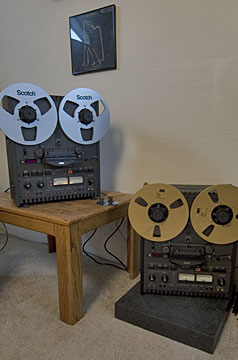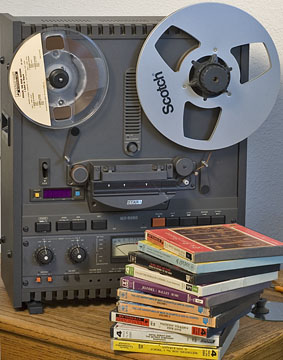-edible zone-
-- 6/29/2008
As those who have been in contact with me lately will
know, I have been getting into the world of open reel tape machines and
the 1/4 inch tape that is played on these. For this moment, I thought it
a good idea to come up for air and make an appraisal of what I've seen
and heard so far.
*
Pictured above: A pair of Otari MX-5050BII-2 1/4 inch tape 1/2-track
machines. Both have the 4th head option which allows 4-track playback..
Back in the sixties and seventies I knew a few different folks
that had this-or-that open reel machine. As a student, I studied music
and played in various bands. Many of these facilities that I was in used
open reel tape to analyze our performances. A most effective tool that
way. On a higher level; what professional musician/composer wouldn't be
without his/her reel to reel! More recently, I've read the odd mention
of "The Tape Project" here and there in the audio press. I've seen the
occasional photo of an open reel machine in the context of system
photos. Some are within the various gallery pages here at The Analog
Dept.
Then I heard some of the demo tapes this fellow Charlie
King was playing on his little Stellavox at VSAC '08 in the AN room. The
sound quality that I heard that day was very, very good. Combine this
with the relative affordability and availability of 'certain' used r2r
machines and it just seemed like a distraction worth pursuing. Compared
to many folks, I've bought into the tape machinery a little late. Prices
on many of the more desirable machines are no longer a giveaway...but, I
suspect, that if a popular interest grows, the prices of the hardware
and software will continue to grow along with it.
Is It A
Resurgent Movement Or A Dead Medium?
Take a cyberspace journey
over to The Tape Project .
https://www.tapeproject.com/. Here is an organization that
appears to be infusing new energy into the medium by producing high
quality "master duplicates" to be played back at 15 ips 1/2 track on 1/4
inch tape. Their goal is to produce 10 titles per year. The best price
offered on these is to buy a 'subscription' which obligates you to buy a
specified number of titles, but at a much lower price than any single
title. So far, only subscribers have any of these tapes.
I
suspect the costs of production are high for this project. Even the cost
of the tape is enough to sink a battleship. In my own searches I find
that a 10.5 inch metal reel, new, and filled with blank 1/4 inch
recording tape will set you back about $49.99. I did manage to find a
sale price on Quantegy 499 Gold Master (was Scotch) 1/4 inch tape in a
10.5 inch reel (2500 ft) for $29.99 through Musician's Friend, a
pro-audio supplier. But that was a sale price, not the regular price.
Consider that a 10.5 inch reel of 1/4 inch tape recorded at 15 ips will
play through in about 33 minutes. In light of that, how many tapes would
you want to buy! Further, the Tape Project is not using high
speed duplication machines like the major record companies did - way
back when. Instead it is making direct transfers from 1-inch 2-track
tape, on an Ampex MM1200 with electronics modified by Tim de Paravicini,
directly to 1/4 inch 2-track tape at 15 ips (real time) using Ampex ATR
100 machines. The method is slow. By all accounts the results are
extraordinary for home listening. I've yet to hear any of these.
Additionally, "The Tape Project" are offering equipment upgrades for
customer machines. One such upgrade is to patch a direct line out from
the tape head to an external tape head preamp. This is said to raise the
quality of output by a considerable margin. Owners who have had this
done tend to proclaim major improvements in sound quality of their open
reel decks.
Another company that is producing high quality
analog master duplicates on 1/4 inch tape is Quinton Records Quinton
Records is in Austria. Link to their site for catalog, prices and to
order.
https://www.quintonrecords.com
About The media: Availability and Durability.
Check Ebay for
the price of pre-recorded tapes these days. The popular titles, the
collectible, the desirable titles are just as pricey, if not more so,
than the collectible - desirable counterpart titles on vinyl.
Consider also the vulnerability of the tape itself to deterioration with
age. High humidity storage is to be avoided. Stable long term
storage-room temperatures are preferred. The binder (adhesive) layer
that holds the media to the substrate can rot. The magnetic tape is
vulnerable to damage by the way it is handled. (Keep your finger prints
off! ) According to The National Media Lab, the projected average
working life of magnetic tape is calculated to be around 10 to 30 years.
Here's a
link
to more info:
link
There are other ways you can damage the tape. If it has a mylar
substrate it is vulnerable to stretching when your machine puts too much
torque-pull against it. A general rule of thumb is to use reels with a
large center hub. See photo below. Both hubs on the Otari pictured below
have large center hubs on the reels mounted. The large center hub will
reduce the amount of force that the machine can pull against the tape.
Improper winding and rewinding can lead to pack problems and make
the tape prone to wrinkle. Such damage can cause flutter in your
playback. Ideally we want the tape to wind in a neat uniform spool with
edges evenly stacked.
Extreme temperature fluctuation in the
storage environment will allow the tape to expand and contract giving
cause for more types of environmental damage. See
link for the full
details. Beware, some photos are explicit!
Ironically, most of
the used commercial tape titles that are being sold these days are well
past 30 years old. Many of these are still in good playable condition.
But others are showing familiar signs of decrepitude like the dreaded
"sticky-shed syndrome". Sticky-shed happens when the binder layer -that
holds the magnetic particles- and is adhered to the substrate - becomes
soft and gummy - loses lubrication - then - tends to stick, bind and
shed during playback. Bad ju-ju.
By comparison, a vinyl Lp, when
correctly handled, played and stored, will not be susceptible to
anything near this level deterioration. More likely, a vinyl Lp, when
stored correctly, could last as long as the projected life expectancy of
pvc left outside to rot in a land fill......that would be just about
forever.
In light of the durability and price issues it is easy
to see why open reel tape takes a back seat to vinyl as the more favored
playback medium. The Lp is simply far more readily available, cheaper
and permanent than is tape.
Q: But, but but what is it that I hear from tape?

-- Above photo: a small assortment of recently acquired 4-track 7.5
ips commercial tapes. Btw, you're not supposed to store these tapes as I
have pictured. They should be up on end. I just did the stack
temporarily for a convenient photo.
A: From the small stack of
commercial 4-track 7.5 ips* tapes that I have I hear a purity of tone
and texture, coherency, very wide sudden dynamic range. Transients are
fast. There is a very snappy, fluid rhythmic drive. The extended high
frequencies are beautifully detailed and airy. Violins and other bowed
string instruments are real. Massed strings in orchestra works are
fleshed out in nice detail. The music seems to flow like a river.
Naturally.
Two of the pre-recorded tapes I bought were recorded
before a live audience. Ok, now what I have to describe next may be
regarded as a psycho-acoustic effect. Somehow hearing a live audience
performance via open reel tape seems to take you closer to the recorded
event compared to playing the same live audience performance on record.
Eerie. At first there was this sensation like I was eves-dropping on the
performance. Psycho-whatever, it's cool.
I do detect a sonic
signature that identifies the medium being played as tape compared to
vinyl. Is it hiss that identifies the tape? It would if it were
prominent but in this case I don't think so . The hiss generated on this
machine, with these tapes, is very soft and not apparent without
listening specifically for it. Is it the noise of a stylus tracing its
way through the vinyl groove versus the noise of tape being uniformly
drawn across the playback head? I'm not sure what it is, but the source
has its signature whether it be vinyl or tape. Oddly enough the vinyl is
a mass produced transcription of a master tape. Some times you can hear
evidence of the tape master within the vinyl recording, but it is still
identifiable to my ear as being vinyl.
As a proud Otari owner I'm
hearing the tape signal that is coming through the 24 yr old Otari
electronics. No question, the sound is very good...but a little lean in
the lower frequencies. I suspect that either a refurbishment/upgrade of
the internal electronics, or perhaps a simple bypass operation to take
the signal directly off the playback head into a standalone tape head
preamp would work wonders and elevate this performance to an entirely
different and higher level. But wait a minute! This is starting to get
expensive! The going price of the used machinery is attractive, mainly,
but that cost is just the tip of the iceberg. The commercial tapes are
not at all cheap...unless you can pick them up for free somewhere. Then
there is the prospect of equipment maintenance costs.
Conclusion
In spite of the apparent draw-backs having to do with the fragile
nature of the tape and the complexity of the equipment, there is
something here very much worth while to audiophiles who enjoy high
quality playback. I think it well worth the bother to get equipped with
a decent open reel machine and start playing the occasional tape. It
makes a refreshing comparison against the vinyl Lp, is obviously
superior to CD and broadens your sonic experience.
_______________________horizontal rule
-- PS: for reels, tape and other r2r supplies check with "pro audio" and "musician supply" stores online or in your neighborhood. That's where they keep the usual stuff. Another source is, inevitably, Ebay.
-- Footnotes:
* Speed of tape as it passes over
the head has a profound effect on frequency response. Typically, 7.5 ips
(inch per second) is considered a good speed for high quality playback.
3-3/4 ips is a commonly seen speed for commercial tapes. This
speed will have dramatically rolled-off high frequencies. Frequency
response at 3-3/4 ips is ~ 30 hz to 10,000 hz. Most people I've talked
with say they avoid this speed and search out the 7.5 ips tapes.
At the other end,15 ips is considered "high speed" for home use and not
all open reel machines have this option. Tapes recorded at 15 ips will
have highest possible fidelity. A very high quality format on 1/4 inch
tape would be 15 ips 2-track.